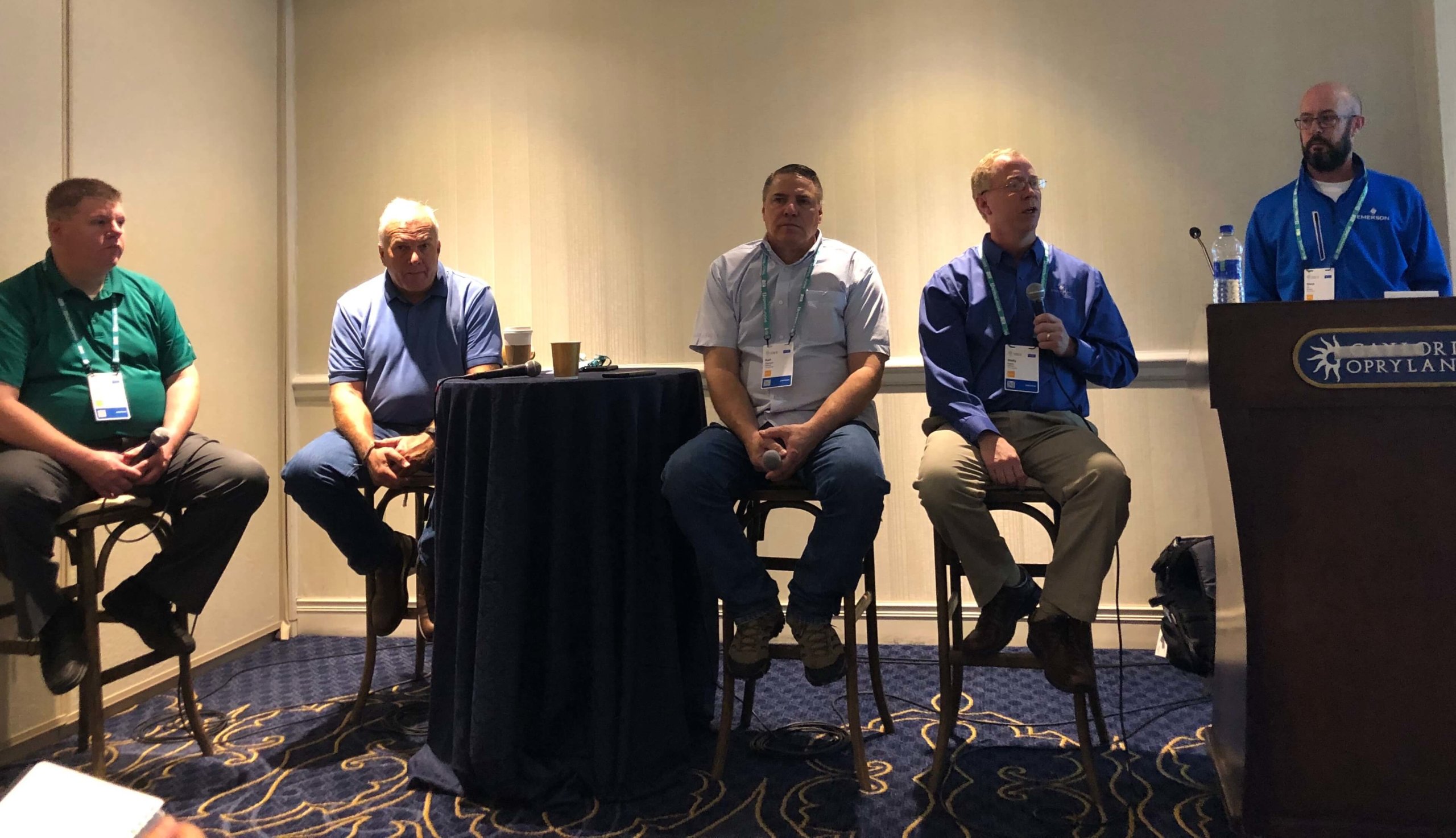It’s been a whirlwind of a week here at the 2019 Emerson Exchange conference in Nashville. The conference comes to a close Friday morning with one last session with the choice of experts’ session. I’m here in the “Selecting the Right Flowmeter” session to learn from Emerson’s Karl Stappert, Martin Schlebach and Steve Ifft. Emerson’s Wally Baker and Trever Ball also joined the fun.
Wally represents vortex meters, Steve represents DP meters, Karl represents Coriolis meters, Martin represents Ultrasonic meters, and Trever represents mag meters. Wally opened describing vortex technology. It operates on the Von Karmen principal by counting the vortex shedding frequency. Think of the waves of a flag flapping in the breeze. Vortex meters are known for high reliability—fit and forget.
Good points include measures gas, liquids with steam, can measure high-temperature and high-pressure fluids, measures across a wide range of flow rates, 2-wire device, low power consumption and easy to install. Disadvantages include only unidirectional flow measurement, obstructs flow stream, not suitable for high-viscosity & slurries.
A question came in, “What or who certifies a flow meter for custody transfer?”. In Europe the OIML certifies but it varies by industry and geography. Europe has MID. In the U.S. it is self-regulated. If it goes to court, the questions will be how compliant with guidelines and recommended practices are they, such as the American Petroleum Institute, etc.
Coriolis flow meters do not require straight line pipe distances upstream and downstream and the other technologies do. Flow conditioners can reduce the straight lengths required but create a pressure drop.
Wally noted that diagnostics in Vortex meters include looking at shedding frequency which can be compared with the volumetric flow measurement to identify any deviations which may affect the measurement accuracy.
This pressure difference can be correlated to flow rate. The advantages include wide use, integrated DP meters save money, orifice (constriction plate) don’t require calibration, any problems are well known, and it’s easy to maintain and troubleshoot. Disadvantages include can’t measure pulsating flows, can measure Newtonian fluids also, and needs maintenance to keep accurate measurements.
Karl described the operation of Coriolis meters that operate on the Coriolis effect which is the only technology that measures mass flow rates without derivation. The meters create a rotating motion by vibrating tubes carrying the flow and measure the inertial force by means of the flow tube deflection, from inlet to outlet, which is proportional to mass flow.
Advantages are not higher than other flow measurement technologies, they can measure the larger quantity phase of a two-phase flow stream to a surprising degree of accuracy, has the highest reproducibility of any flow technology, and is a high-precision small quantity batching (filling) and blending meter. Disadvantages are the need to place close attention in mounting and supporting the meter, under sizing a Coriolis meter in proving applications (small meter—big flow), and burying the case of a Coriolis meter is not a good practice.
A question on noise and vibration about Coriolis meters came in. As long as the frequencies in these disturbances are not in the resonant frequency of the meter there is no effect. If the frequencies align, then the signal becomes jittery and bounces around. It’s important to pay attention to the installation and provide support to avoid these resonant frequencies.
If there is no two-phase flow, it doesn’t matter the mounting orientation of a Coriolis flow meter. If there is even a chance, flag position is best, with liquids flowing up and gases flowing down.
Martin described the operation of Ultrasonic flowmeters. An ultrasonic sound wave is sent across the pipe and the transit time is measured. When flowing, the transit times are different representing fluid velocity. There is no pressure drop across the meter. There are no obstructions in the flow stream, no moving parts and upstream pipe diameters as short as 5 diameters with no flow conditioning. Velocity ratios are up to 100 to 1. Disadvantages are that they are designed to measure, but the liquid volume fractions need to be below 1%. Higher levels affect accuracy. They are sensitive to ultrasonic noise from valves and piping. Buildup on pipe walls can skew the volumetric calculation.
Trever described how magnetic flow meters that work based on Faraday’s Law of magnetic induction (think shaker flashlights). Mag meters are known for their versatility, reliability, and performance in conductive liquid applications. Advantages are versatility and cost effective for aggressive chemicals, they have meter verification and advanced diagnostics, and can be used on mixtures with non-conductive fluids as long as one component is conductive. Disadvantages is that not all water is created equal and conductivity can vary. Watch out for applications with changing conductivity, especially if they are operating at the margin of the meter. The is a great technology for slurry flow applications.
If the right materials and installation is performed, mag meters are very reliable with little or no need for maintenance.
Visit the Flow Measurement section on Emerson.com for more on these and other flow measurement technologies.

